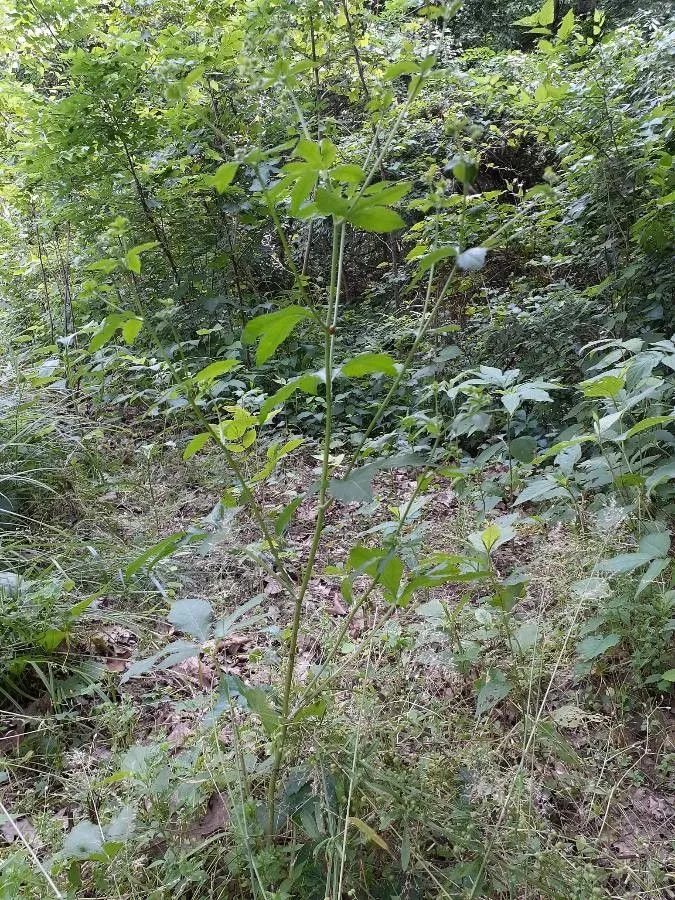
Author: L.
Bibliography: Sp. Pl.: 235 (1753)
Year: 1753
Status: accepted
Rank: species
Genus: Sanicula
Vegetable: False
Observations: SE. Canada to C. & E. U.S.A.
Canada sanicle, known scientifically as Sanicula canadensis, is a plant native to southeastern Canada and central to eastern regions of the United States. This member of the Apiaceae family was first described by the renowned botanist Carl Linnaeus in his seminal work Species Plantarum, published in 1753.
Sanicula canadensis thrives in a variety of habitats, ranging from moist woodlands to fields and roadside edges. It is commonly observed in areas with rich, well-draining soil and partial to full shade. The plant features a cluster of small, pale yellow to greenish-white flowers that bloom from late spring to early summer. These flowers are arranged in umbels, a characteristic floral structure of the Apiaceae family.
The leaves of Canada sanicle are dark green and intricately lobed, adding texture and depth to the undergrowth of deciduous forests where it typically resides. Its roots are fibrous, allowing the plant to anchor itself securely in diverse terrains and access nutrients efficiently.
Canada sanicle plays an integral role in its ecosystem. As a native species, it supports local biodiversity by providing nectar and pollen for a variety of pollinators, including bees and butterflies. Additionally, it serves as a larval host plant for certain butterfly species, thereby contributing to their life cycles.
Historically, indigenous peoples and settlers have recognized the medicinal properties of Sanicula canadensis. Traditionally, various parts of the plant were used to treat ailments such as wounds, respiratory issues, and digestive problems, underscoring its long-standing significance in ethnobotany.
Despite its widespread presence, Canada sanicle is often overlooked in favor of more conspicuous flora. However, its subtle beauty and ecological importance make it a noteworthy component of the North American flora.
In summary, Sanicula canadensis is a vital and resilient species native to Canada and the United States, with a rich history of use and ecological contributions. Its presence in diverse habitats enhances local flora diversity and supports an array of pollinators and herbivores.
Eng: canada sanicle, canadian black snakeroot, canadian blacksnakeroot, black snakeroot, canada black-snakeroot, canada snakeroot
Fra: sanicle du canada, sanicule du canada
En: Canada sanicle, Canadian black snakeroot, Canadian blacksnakeroot, Black Snakeroot, Canada black-snakeroot, Canada snakeroot
Fr: Sanicle du Canada, Sanicule du Canada
Taken Jul 29, 2014 by karen (cc-by-sa)
Taken Aug 9, 2022 by Danielle danielle (cc-by-sa)
Taken May 24, 2020 by Kyle Grubb (cc-by-sa)
Taken Jun 7, 2020 by Nate Szkil (cc-by-sa)
Taken Jun 4, 2019 by Leah Harrison (cc-by-sa)
Taken May 31, 2021 by Rami Assaf (cc-by-sa)
Taken Jun 19, 2022 by Lillian Kerekgyarto (cc-by-sa)
Taken May 31, 2021 by Rami Assaf (cc-by-sa)
Taken May 24, 2022 by Micah Mullennix (cc-by-sa)
Taken May 19, 2020 by Miranda MirandaLeigh (cc-by-sa)
Taken May 21, 2004 by EOL − Steven J. Baskauf (cc-by-nc-sa)
Taken May 5, 2004 by EOL − Steven J. Baskauf (cc-by-nc-sa)
Taken May 17, 2015 by EOL − Jim Varnum (cc-by-nc)
Taken May 24, 2020 by Aaron Harp (cc-by-sa)
Taken May 24, 2020 by Kyle Grubb (cc-by-sa)
Taken Jun 16, 2021 by Josh M (cc-by-sa)
Taken May 24, 2020 by Kyle Grubb (cc-by-sa)
Taken Jan 1, 1900 by EOL − John Hilty (cc-by-nc)
Taken May 21, 2004 by EOL − Steven J. Baskauf (cc-by-nc-sa)
Taken May 5, 2004 by EOL − Steven J. Baskauf (cc-by-nc-sa)
Taken Jul 19, 2021 by Courtney Wiseman (cc-by-sa)
Taken Jul 7, 2019 by A.R. Johnson (cc-by-sa)
Taken Jul 19, 2021 by Courtney Wiseman (cc-by-sa)
Taken Aug 29, 2022 by tomhuck88 (cc-by-sa)
Taken Aug 29, 2022 by tomhuck88 (cc-by-sa)
Growth habit>: Forb/herb
Family: Myrtaceae Author: (F.Muell.) K.D.Hill & L.A.S.Johnson Bibliography: Telopea 6: 402 (1995) Year: 1995 Status:…
Family: Rubiaceae Author: Pierre ex A.Froehner Bibliography: Notizbl. Bot. Gart. Berlin-Dahlem 1: 237 (1897) Year:…
Family: Sapindaceae Author: Koidz. Bibliography: J. Coll. Sci. Imp. Univ. Tokyo 32(1): 38 (1911) Year:…
Family: Asteraceae Author: A.Gray Bibliography: Pacif. Railr. Rep.: 107 (1857) Year: 1857 Status: accepted Rank:…
Family: Fabaceae Author: Medik. Bibliography: Vorles. Churpfälz. Phys.-Ökon. Ges. 2: 398 (1787) Year: 1787 Status:…
Family: Aspleniaceae Author: (Cav.) Alston Bibliography: Bull. Misc. Inform. Kew 1932: 309 (1932) Year: 1932…